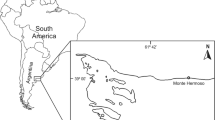Abstract
A mosaic patchwork of the barnacle Balanus balanoides L., the mussel Mytilus edulis L., and the alga Fucus vesiculosus L. was found in the transitional region between the mid and high intertidal zones on a rocky headland on Mount Desert Island, Maine, USA. The development of the mosaic was observed by following recruitment and survival of B. balanoides in denuded patches located at the same tidal level along a 60 m stretch of shore. Barnacle recruitment was least under canopies of F. vesiculosus and greatest in open areas kept moist at low tide by surf. Barnacle survival after settlement was least under the F. vesiculosus canopy due to the whiplash effect of the algal fronds in the surf and greatest in open areas free from competition from mussels. In open areas, early mortality was correlated with settlement density. In areas of dense settlement (60 spat cm-2) up to 90% mortality resulted within 5 months from crowding associated with growth. In older individuals crowding produced hummocks of elongated, weakly attached barnacles which were more prone to removal by surf than uncrowded barnacles. Mussels exerted competitive dominance over barnacles for space and the presence of mussel beds prevented further barnacle recruitment. Mussels suffered extensive mortality during winter storms when surf removed dense mats of weakly attached mussels. The patchy distribution of mussels and barnacles results from irregular rock substrata producing numerous environmental patches with respect to wave exposure and drainage at low tide, and from densitydependent mortality of both mussels and barnacles which creates patches of new colonizable space within each environmental patch.
Similar content being viewed by others
Literature cited
Barnes, H. and H.T. Powell: The development, general morphology and subsequent elimination of barnacle populations, Balanus crenatus and B. balanoides, after a heavy initial settlement. J. Anim. Ecol. 19, 175–179 (1950)
—— The growth of Balanus balanoides (L) and B. crenatus Brug under varying conditions of submersion. J. mar. biol. Ass. U.K. 32, 107–127 (1953)
Chapman, C.A.: The geology of Acadia National Park, 128 pp. New Haven, Conn.: Chatham Press 1970
Coast and Geodetic Survey: Tide tables, east coast, North and South America (including Greenland), Washington, D.C.: U.S. Government Printing Office 1973
Connell, J.H.: Effects of competition, predation by Thais lapillus, and other factors on natural populations of the barnacle Balanus balanoides. Ecol. Monogr. 31, 61–104 (1961a)
— The influence of interspecific competition and other factors on the distribution of the barnacle Chthamalus stellatus. Ecology 42, 710–723 (1961b)
— A predator-prey system in the marine intertidal region. I. Balanus glandula and several predatory species of Thais. Ecol. Monogr. 40, 49–78 (1970)
— Community interactions on marine rocky intertidal shores. A. Rev. Ecol. Syst. 3, 169–192 (1972)
Crisp, D.J.: Factors influencing growth rate in Balanus balanoides. J. Anim. Ecol. 29, 95–116 (1960)
— and P.S. Meadows: Adsorbed layers: the stimulus to settlement in barnacles. Proc. R. Soc. (Ser. B) 158, 364–382 (1963)
Dayton, P.K.: Competition, disturbance, and community organization: the provision and subsequent utilization of space in a rocky intertidal community. Ecol. Monogr. 41, 351–389 (1971)
Harger, J.R.E. and D.E. Landenberger: The effect of storms as a density dependent mortality factor on populations of sea mussels. Veliger 14, 195–201 (1971)
Hatton, H.: Essais de bionomie explicative sur quelques espèces intercôtidales d'algues et d'animaux. Annls Inst. océanogr., Monaco 17, 241–348 (1938)
Kanwisher, J.W.: Freezing in intertidal animals. Biol. Bull. mar. biol. Lab., Woods Hole 109, 56–63 (1955)
Lewis, R.R.: The ecology of rocky shores, 323 pp. London: English University Press 1964
Meadows, P.S.: Settlement, growth and competition in sublittoral populations of barnacles. Hydrobiologia 33, 65–92 (1969)
Menge, B.A.: Organization of the New England rocky intertidal community: role of predation, competition, and environmental heterogeneity. Ecol. Monogr. 46, 355–393 (1976)
— and J.P. Sutherland: Species diversity gradients: synthesis of the roles of predation, competition, and environmental stability. Am. Nat. 110, 351–369 (1976)
Moore, H.B.: The biology of Balanus balanoides. I. Growth rate and its relation to size, season and tidal level. J. mar. biol. Ass. U.K. 19, 851–868 (1934)
Paine, R.T.: Food web complexity and species diversity. Am. Nat. 100, 65–75 (1966)
Widdowson, T.B.: A survey of the distribution of intertidal algae along a coast transitional in respect to salinity and tidal factors. J. Fish. Res. Bd Can. 22, 1425–1454 (1965)
Author information
Authors and Affiliations
Additional information
Communicated by J.S. Pearse, Santa Cruz
Rights and permissions
About this article
Cite this article
Grant, W.S. High intertidal community organization on a rocky headland in Maine, USA. Mar. Biol. 44, 15–25 (1977). https://doi.org/10.1007/BF00386900
Accepted:
Issue Date:
DOI: https://doi.org/10.1007/BF00386900




